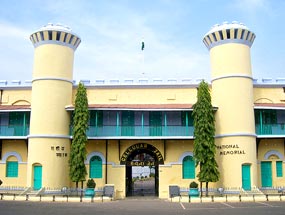The historical Cellular Jail is situated in Port
Blair, the capital of Andaman & Nicobar Islands of India.
Cellular Jail

Location: Port Blair, Andaman & Nicobar
Islands
Founded In: 1896-1906
Founded By: The British
Served As: Prison during India's freedom struggle
Cellular Jail was constructed under the British rule, in the year 1906,
to serve as a prison for the Indian activists who participated in
India's freedom struggle. During that time, it was also known as Kala
Pani, meaning 'Black water', the term that is used for deep sea and
implies exile. The jail is situated in Port Blair, the capital of
Andaman & Nicobar Islands. Though the construction work on the
prison was started only in the year 1896, the British had starting using
Andaman & Nicobar Islands as prison as early as 1857.
The islands were believed to be the perfect place to serve as the
prison venue, since they were isolated from the mainland and severed the
links of the prisoners with their family and their country completely.
At the same time, the prisoners could be used in chain gangs to
construct prisons, buildings and harbor facilities. By the late
nineteenth century, the population of prisoners started increasing at a
fast pace. It was then that the need for a high-security prison was felt
by the British and the foundation of the Cellular Jail was laid in Port
Blair.
Initially, the Cellular Jail was a puce-colored brick building, for
which the bricks were brought from Burma (now Myanmar). There were seven
wings, with a central tower serving as the fulcrum. Guards used this
tower for keeping a watch over the prison inmates. Each and every wing
of the prison had three stories, with the total number of cells being
698. Each cell was 4.5 m x 2.7 m in size and there was a ventilator in
each cell, situated at a height of 3 m. The cells were built in such a
way so as to prevent any interaction between the inmates.
This solitary formation of the cells led to the naming of the prison as
the 'Cellular Jail'. There were no dormitories in the prison. Most of
the prisoners that were deported to the jail were independence
activists. The political prisoners of Cellular Jail were repatriated to
the mainland in 1937-38. The Andaman Islands came under invasion by the
Empire of Japan in the year 1942, in which the British lost. The jail,
which earlier housed prisoners of the British, now became a penitentiary
for the British officers and soldiers.
Later, Indian Independence League members were also imprisoned here,
tortured and then, killed. Under the Japanese regime, two of the wings
of the Cellular jail were demolished. After the end of World War II, the
British reoccupied the islands in 1945. When India attained
independence, two more wings of the jail were pulled down. After
protests by the former prisoners and political leaders, the demolition
was stopped and the remaining three wings and central tower were
converted into a National Memorial.
Govind Ballabh Pant Hospital was set up inside the premises of the
Cellular Jail in the year 1963. The hospital has since been expanded and
has 500 beds, with about 40 doctors serving the local population. The
Indian Ocean Tsunami, which came in 2004, heavily damaged the Cellular
Jail of Port Blair. Approximately a year back, on 10th March 2006,
Government of India organized the Centenary celebrations of the Jail. A
felicitation ceremony was also organized as a part of the celebrations,
where the Government felicitated erstwhile prisoners.


